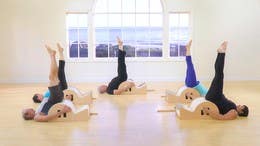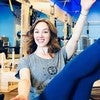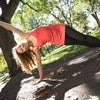Description
About This Video
Transcript
Read Full Transcript
I'm Ken Gilbert. I'm here at, I applaud his any time to present a tutorial on the five primary joint actions of the spine and the two classes that we'll be doing in my session today. We'll be doing a mat class as well as the spine corrector classes. You'll be able to view on the site as well and see how I apply these particular cues and skills of the spine while I'm teaching. While I'm demonstrating what I'd like to see from the spine in our theater company as well as my [inaudible] classes and Nia classes, I'm observing the spine in its actions. How does the spine move? Is it moving with clarity? Is it, I love this term, intervertebral articulation.
It took me a year to learn how to say that. Easily intervertebral articulation. The space between this vertebra, how do they move? Even though some parts of the spine, the lumbar is a little bit more compressed than the thoracic, a little bit more open than the cervical, so of course that was the spine, the the playfulness of the vertebral one to another is what I want to see. It's expressivity, it's functional, and it's also a movement that I look for. How does the spine move?
So Amy's here to help me demonstrate for how I like to see the spine move. So the five joint actions we have forward flection, we have lateral flection, we have extension, we have rotation and we have circumduction. So let's play with forward flection first I like to refer to the high point. It's a part of the spine at the bottom of the sternum at the bottom of the rib cage in the back high point, or I called it a center core. It's a pivot point of the spine, right between the, it's at the top of the lumbar bottom of the thoracic.
It's a place where we move all day long. And what I'd like to do is is to see people empower that center so that they have an ability to understand where they are in their pelvis, chest and head, the three body weights of a, of a strong spine. What I like to look for is how is the person standing. I look for any tensions that they carry in their body. So looking at the spine now forward flection is forward fluxion from this high point or the center core here and then coming up, there's the extension.
We're not going to full extension, it's just a return and forward fluxion moving forward from there. What I'd like to see also as an opening of the back of the shoulder blades so that there's more movement. The body loves to move into space and so if we create more space, we have more movement. So if she put let's do it, let's do it this way, pull your shoulder blades together and now go into forward flection. Keep your shoulders together. There's not much for reflection that can happen. So as she widens her shoulder blade, you'll hear me que that a lot when I teach.
Then she has all of that space in which to move all of this space in which to move forward flection and one more time forward, flection forward flection of the spine from the high point or the center core and then extension. That's the back. So as if she's going over a ball, a barrel or something that has a curve to it. The more she connects to her lower belly here, stabilizing the pelvis, the more extension she's going to get. Again, walk, wanting to move into that space and volume. The spine will move. Drop Your Chin just a bit and see if we can get more extension through the thoracic here from the bottom of of the sternum here. Good. And then coming up. So extension, the third joint action is lateral flection bending to the side. And we were talking about this earlier today.
There is lateral flection here on this side. Now for her to return, she's actually going through a lateral extension cause he's extending the spine, a lateral flection and then coming back. So what I like to see here is that she lifts from here, so she's lifting as she goes into flection. So there's no compression into the discs. The intervertebral articulation is more systemic of the spine, more inclusive of all the Vertebra of course being most stable in the lumbar. One more time, each side, lateral flection and then coming up to center and then lateral flection coming up to center. And then let's place the halo of, I call it the halo of the pelvis. So right across the pubis, the halo of the pelvis, right across the clavicle and there the shoulder blades right across the eyes.
So we have those three Halos of the pelvis, chest and head. Now rotation is when she moves the shoulder girdle and the head separate from the pelvis or rotation. Now the pelvis and the lumbar can rotate slightly. However I like to play with that, that yawning of the back and really asking the QL and the intercostals, the lats and all four of the primary abdominals to work together to create that sense of movement, this pivot on an axis, the rotation. It's really nice to see the rotation with the stable pelvis like that.
And then the final one is circumduction. That involves forward flection, lateral flection, extension and lateral flection. So going to the forward fluxion pivoting on a point, now she's going to lateral flection, now she goes into extension and then to lateral flection and then forward fluxion again, go the other way and then lateral and then extension back extension, lateral forward flection. So do it one more time each way. So circumduction pivoting on the point of the highs point, the center core, pivoting on the point, this is a joint action that most of us do all through the day. Getting in and out of things, getting in and out of chairs, getting in and out of car seat, various different things. So the five primary joint actions of the spine, it allows the spine to be mechanically developing the muscularity, the flexibility, the strength.
It also allows them and expressively coming from the spine as the spine moves. You'll see that demonstrated in both the mat and the spine corrector classes. Thank you.
Comments
wonderful actions to begin any type of class, Im heading to your right now :)
You need to be a subscriber to post a comment.
Please Log In or Create an Account to start your free trial.


















